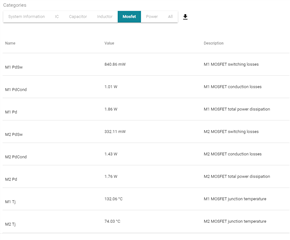Other Parts Discussed in Thread: CSD17573Q5B, , CSD17309Q3, TPS40425
Hi Teams,
In WEBENCH@ POWER DESIGNER, I select LM27403 (buck controller with discrete NMOSs) in DC/DC Power Designs. TPS40425 is a single phase controller combined with discrete NMOSs. In DC/DC Power Designs, I set the condition with VIN=12V, VOUT=1V, IOUT=40A an Ta=30℃. The high side MOSFET is generated to CSD17309Q3 (30V, RON=4.9mΩ@VGS=4.5V, PKG=3.3mm x 3.3mm, θJA=45℃/W) x1 and the low side MOSFET is generated to CSD17573Q5B (30V, RON=1.19mΩ@VGS=4.5V, PKG=5mm x 6mm, θJA=40℃/W) x2. In my awareness, low side MOSFET is unreasonable in output current 40A design. What's optimizing logic or methodology in this tool? Is it related to RON, PKG and θJA? Is the key limitation is θJA? But, θJA is based on PCB conditions. It seems to difficult to design it.


